Dhaka capital of bangladesh
Dhaka (Bengali: ঢাকা, pronounced [ɖʱaka]; /ˈdɑːkə/ DAH-kə or /ˈdækə/ DAK-ə) is the capital and largest city of Bangladesh. The name of the city was spelled as Dacca,
which was an anglicisation name until the current spelling was adopted
in 1983 to match with Bengali pronunciation.Located in an eponymous
district and division, it lies along the east bank of the Buriganga
River in the heart of the Bengal delta. The city is a microcosm
of the entire country, with diverse religious and ethnic communities.
Dhaka is the economic, cultural and political center of Bangladesh. It
is a major financial center of South Asia. It is one of the world's most
populated cities and within OIC countries, with a population of 18.89
million people in the Greater Dhaka Area.It is also the 4th most densely
populated city in the world.
At the height of its medieval glory, Dhaka was regarded as one of the wealthiest and most prosperous cities in the world.It served as the capital of the Bengal province of the Mughal Empire twice (1608–39 and 1660–1704).The city's name was Jahangir Nagar (City of Jahangir) in the 17th century. It was central to the economy of Mughal Bengal, which generated 50% of Mughal GDP.It was a cosmopolitan commercial center and the hub of the worldwide muslin and silk trade.
The Mughals decorated the city with well-laid out gardens, tombs, mosques, palaces and forts. Dhaka became known as the City of Mosques in Bengal.It was also described as the Venice of the East.The old city was home to various Eurasian merchant groups. The city hosted two important caravansaries of the subcontinent: the Bara Katra and Choto Katra, located on the riverfront of the Buriganga. Modern Dhaka developed from the late 20th century. Between 1905 and 1912, it was the capital of British Eastern Bengal and Assam.In 1947, after ending of British rule, it became the administrative capital of the East Pakistan. It was declared as the legislative capital of Pakistan in 1962. In 1971, it became the capital of an independent Bangladesh.
Dhaka is home to most of the local business conglomerate. Many multinational companies also maintain offices in the city. Dhaka Stock Exchange is one of the largest in South Asia in terms of trading volume and market capitalization.The city is home to a number of regional and international training and development organizations, such as permanent secretariat of BIMSTEC. The city has the largest number of cycle rickshaws and is known as the Rickshaw Capital of the World.
At the height of its medieval glory, Dhaka was regarded as one of the wealthiest and most prosperous cities in the world.It served as the capital of the Bengal province of the Mughal Empire twice (1608–39 and 1660–1704).The city's name was Jahangir Nagar (City of Jahangir) in the 17th century. It was central to the economy of Mughal Bengal, which generated 50% of Mughal GDP.It was a cosmopolitan commercial center and the hub of the worldwide muslin and silk trade.
The Mughals decorated the city with well-laid out gardens, tombs, mosques, palaces and forts. Dhaka became known as the City of Mosques in Bengal.It was also described as the Venice of the East.The old city was home to various Eurasian merchant groups. The city hosted two important caravansaries of the subcontinent: the Bara Katra and Choto Katra, located on the riverfront of the Buriganga. Modern Dhaka developed from the late 20th century. Between 1905 and 1912, it was the capital of British Eastern Bengal and Assam.In 1947, after ending of British rule, it became the administrative capital of the East Pakistan. It was declared as the legislative capital of Pakistan in 1962. In 1971, it became the capital of an independent Bangladesh.
Dhaka is home to most of the local business conglomerate. Many multinational companies also maintain offices in the city. Dhaka Stock Exchange is one of the largest in South Asia in terms of trading volume and market capitalization.The city is home to a number of regional and international training and development organizations, such as permanent secretariat of BIMSTEC. The city has the largest number of cycle rickshaws and is known as the Rickshaw Capital of the World.
Etymology
The origins of the name for Dhaka are uncertain. Once dhak trees were very common in the area and the name may have originated from it. Alternatively, this name may refer to the hidden goddess Dhakeshwari, whose temple is located in the south-western part of the city.Another popular theory states that Dhaka refers to a membranophone instrument, dhak which was played by order of Subahdar Islam Khan I during the inaugurating of the Bengal capital in 1610.Some references also say that it was derived from a Prakrit dialect called Dhaka Bhasa; or Dhakka, used in the Rajtarangini for a watch-station; or it is the same as Davaka, mentioned in the Allahabad pillar inscription of Samudragupta as an eastern frontier kingdom. According to Rajatarangini written by a Kashmiri Brahman, Kalhana. the region was originally known as Dhakka. The word Dhakka means watchtower. Bikrampur and Sonargaon—the earlier strongholds of Bengal rulers were situated nearby. So Dhaka was most likely used as the watchtower for the fortification purpose.
History
Early history

Ruins of Lalbagh Fort

A Bengali woman wearing muslin in Dhaka in 1789

Old High Court of Dacca
15th to 18th centuries
The Mughal Empire governed the region during the late 15th-18th century. Under Mughal rule, the Old City of Dhaka grew on the banks of the Buriganga River. Dhaka was proclaimed the capital of Mughal Bengal in 1608. Islam Khan Chishti was the first administrator of the city. Khan named it "Jahangir Nagar" (City of Jahangir) in honour of the Emperor Jahangir. The name was dropped soon after the English conquered. The main expansion of the city took place under Mughal governor Shaista Khan. The city then measured 19 by 13 kilometres (11.8 by 8.1 mi), with a population of nearly one million. Dhaka was one of the largest and most prosperous cities in South Asia. It grew into a regional economic center during the 15th and 18th centuries, serving as a hub for Eurasian traders, including Bengalis, Marwaris, Kashmiris, Gujaratis, Armenians, Arabs, Persians, Greeks, Dutch, French, English and the Portuguese. The city was a center of the worldwide muslin, cotton and jute industries, with 180,000 skilled weavers. Mughal Bengal generated 68% of the Mughal Empire's GDP, which at the time constituted 29% of world GDP. Dhaka was the commercial capital of the empire. The city had well-laid out gardens, monuments, mosques, temples, bazaars, churches and caravansaries. The Bara Katra was the largest caravansary. The riverbanks were dotted with tea houses and numerous stately mansions. Eurasian traders built neighborhoods in Farashganj (French Bazaar), Armanitola (Armenian Quarter) and Postogola (Portuguese Quarter).Bengal was an affluent region with a Bengali Muslim majority and Bengali Hindu minority, and was globally dominant in industries such as textile manufacturing and shipbuilding. The capital Dhaka had an estimated 80,000 skilled textile weavers. It was an exporter of silk and cotton textiles, steel, saltpeter, and agricultural and industrial produce.
British colonial period
With the defeat of the Nawab of Bengal at the Battle of Buxar in 1764, British East India company gained the right to collect taxes from the Mughal province of Bengal-Bihar. The city formally passed to the control of the British East India Company in 1793 and Dhaka got plugged into the imperial mercantile networks of the British Empire.[33] With the dawn of the Industrial Revolution in Great Britain, Dhaka became a leading centre of the jute trade, as Bengal accounted for the largest share of the world's jute production.
Dhaka, or Dacca, under British rule in 1861
 t
t
Ahsan Manzil
Ahsan Manzil was once the palace of the Dhaka Nawab Family; it is now a national museum
Pakistan period
With the Partition of British India in 1947, Dhaka became the capital of East Pakistan. The city's population increased dramatically because of Muslim migration from across Bengal and other parts of the subcontinent, putting heavy strains on infrastructure.The Awami League was formed at the Rose Garden Palace in 1949 as the Bengali alternative to the domination of the Muslim League in Pakistan.Growing political, cultural and economic rifts emerged between the two wings of the country. The Bengali Language Movement reached its peak in 1952.Dhaka remained a center of revolutionary and political activity, as student activism and demands for autonomy increased. The Six point movement in 1966 was widely supported by the city's residents. The city had an influential press, with prominent newspapers like the Ittefaq and the Weekly Holiday. During the political and constitutional crisis in 1971, the military junta led by Yahya Khan refused to transfer power to the newly elected National Assembly, causing mass riots, civil disobedience and a movement for self-determination. On 7 March 1971, Awami League leader Sheikh Mujibur Rahman addressed a massive public gathering at the Ramna Race Course Maidan in Dhaka, in which he warned of an independence struggle.Subsequently, East Pakistan came under a non-co-operation movement against the Pakistani state. On Pakistan's Republic Day (23 March 1971), Bangladeshi flags were hoisted throughout Dhaka in a show of resistance.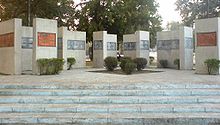
Memorial to the 1971 Dhaka University massacre
After independence
The post-independence period witnessed rapid growth as Dhaka attracted migrant workers from across rural Bangladesh. In August 1975, Sheikh Mujib was assassinated in an internal coup d'état. There were further chaos and uprisings in November 1975. An actual military coup was undertaken on 24thMarch 1982 by the sitting Army chief of staff. In the 1980s, Bangladesh pioneered the formation of the South Asian Association for Regional Cooperation (SAARC) and hosted its first summit in Dhaka.A mass uprising in 1990 led to the removal of then Indian backed government and the return of parliamentary democracy. In the 1990s and 2000s, Dhaka experienced improved economic growth and the emergence of affluent business districts and satellite towns.Geography
Topography

View of Dhaka from the International Space Station
Climate
Under the Köppen climate classification, Dhaka has a tropical savanna climate. The city has a distinct monsoonal season, with an annual average temperature of 26 °C (79 °F) and monthly means varying between 19 °C (66 °F) in January and 29 °C (84 °F) in May.[53] Approximately 87% of the annual average rainfall of 2,123 millimetres (83.6 inches) occurs between May and October. Increasing air and water pollution emanating from traffic congestion and industrial waste are serious problems affecting public health and the quality of life in the city.Water bodies and wetlands around Dhaka are facing destruction as these are being filled up to construct multi-storied buildings and other real estate developments. Coupled with pollution, such erosion of natural habitats threatens to destroy much of the regional biodiversity.Parks and greenery
There are many parks within Dhaka city, including Ramna Park, Suhrawardy Udyan, Shishu Park, National Botanical Garden, Baldha Garden, Chandrima Uddan, Gulshan Park and Dhaka Zoo. There are lakes within city, such as Crescent lake, Dhanmondi lake, Baridhara-Gulshan lake, Banani lake, Uttara lake and Hatirjheel-Begunbari lake.Hatirjheel-Begunbari, which was once a slum area, has turned into a new place of recreation for city dwellers. Hatirjheel covering 320 acres (129 ha) is transformed into a place of festivity at night but with serenity settling down. However, the parks and the recreation places are often crowded and lacks security and cleanliness aspects, which is yet one of the big issues.
-
 Three Leaders Mausoleum, Suhrawardy Udyan, Shahbag
Three Leaders Mausoleum, Suhrawardy Udyan, Shahbag -
 Baldha Garden, Old Dhaka
Baldha Garden, Old Dhaka -
 Crescent Lake, Parliament District
Crescent Lake, Parliament District -
 Khawja Hafizullah Obelisk in Bahadur Shah Park
Khawja Hafizullah Obelisk in Bahadur Shah Park
Government
Capital city
 narional parlament
narional parlament
The National Parliament House in Sher-e-Bangla Nagar
Dhaka hosts 54 resident embassies and high commissions and numerous international organizations. Most diplomatic missions are located in Gulshan and Baridhara area of the city. The Agargaon area near Parliament is home to the country offices of the United Nations, the World Bank, the Asian Development Bank and the Islamic Development Bank.
Civic administration
 nagar vaban
nagar vaban - Dhaka City Corporation is a self-governing corporation which runs the affairs of the city. Dhaka municipality was founded on 1 August 1864,and upgraded to "Metropolitan" status in 1978. In 1983 City Corporation was created to govern Dhaka.Under new act in 1993, election was held in 1994 for the first elected Mayor of Dhaka.In 2011, Dhaka City Corporation was split into two separate corporations – Dhaka North City Corporation and Dhaka South City Corporation for ensuring better civic facilities.These two corporations are headed by two two mayor, who are elected by direct vote of the citizen for a 5-year period. Area within city corporations divided into several wards, which each have an elected commissioner. In total the city has 130 wards and 725 mohallas.
- RAJUK is responsible for coordinating urban development in Greater Dhaka area.
- DMP is responsible for maintaining law & order within the metro area. It was established in 1976. DMP has 56 police stations as administrative units.
Administrative agencies
Unlike other mega cities around the world, Dhaka is serviced by over two dozen government organizations under different ministries. Lack of co-ordination among them and centralization of all powers by the Government of Bangladesh, keeps the development and maintenance of the city in a chaotic situation.| Agency | Service | Parent agency |
|---|---|---|
| Dhaka North City Corporation Dhaka South City Corporation |
Public service | Ministry of Local Government, Rural Development and Co-operatives ∟ Local Government Division |
| Dhaka Metropolitan Police | Law enforcement | Ministry of Home Affairs ∟ Bangladesh Police |
| RAJUK | Urban planning | Ministry of Housing and Public Works |
| Dhaka Electric Supply Company Limited Dhaka Power Distribution Company Limited |
Power distribution | Ministry of Power, Energy and Mineral Resources ∟ Power Division |
| Dhaka WASA | Water supply | Ministry of Local Government, Rural Development and Co-operatives ∟ Local Government Division |
| Dhaka Transport Coordination Authority | Transportation | Ministry of Road Transport and Bridges ∟Road Transport and Highways Division |
Economy

City Centre – currently the tallest building of Bangladesh, at Motijheel business district in Dhaka
Major Bangladeshi companies headquartered in the Dhaka include Beximco, Rahimafrooz, Summit, Biman Bangladesh Airlines, Petrobangla, Akij Group, Bashundhara Group, Jamuna Group, Transcom Group, Aarong, PRAN-RFL Group and Square Pharmaceuticals among others. Dhaka is the center of the Bangladesh textile industry. The technologically advanced Bangladeshi pharmaceutical industry is also concentrated in Dhaka.

Jamuna Future Park at Kuril, Baridhara in Dhaka, which is the largest shopping mall in South Asia

Gulshan Lake, Dhaka North (Left Gulshan Neighborhood, Right Badda Neighborhood)
Demographics
 Play media
Play media
NASA animation showing the urban growth of Dhaka from 1972 to 2001.
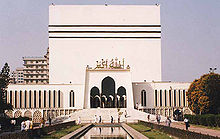
Baitul Mukarram National Mosque

Dhakeshwari National Temple
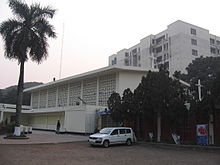
St. Mary's Cathedral, Dhaka
The city population is composed of people from virtually every region of Bangladesh. The long-standing inhabitants of the old city are known as Dhakaia and have a distinctive dialect and culture. Between 15,000 and 20,000 of the Rohingya, Santal, Khasi, Garo, Chakma and Mandi tribal peoples reside in the city. Dhaka also has a large population of European, Chinese, Korean, Indian, Pakistani, Nepali, Burmese and Sri Lankan expatriates working in executive jobs in different industries. Dhaka is also home to over 300,000 Bihari refugees, who are descendants of migrant Muslims from eastern India during 1947 and settled down in East Pakistan. The correct population is ambiguous; although official figures estimate at least 40,000 residents, it is estimated that there are at least 300,000 Urdu-speakers in all of Bangladesh, mostly residing in refugee camps in Dhaka.
Bengali, the national language, is spoken by the predominant majority population of Dhaka. English is the principal second language and widely spoken by educated peoples. There is a minority Urdu-speaking population from India and Pakistan. Islam is the dominant religion of the city, with 90% of the population being Muslim, and a majority belonging to the Sunni sect. There is also a small Shia sect, and an Ahmadiya community. Hinduism is the second-largest religion and comprises 8.2% of the population. Smaller segments practice Christianity and Buddhism.The city also has Ismaili, Sikh, Hrishi & Bahá'í Faith communities.
Culture
Arts and festivals

The Central Shaheed Minar on Language Movement Day
Pohela Baishakh, the Bengali New Year, falls annually on 14 April and is popularly celebrated across the city.Large crowds of people gather on the streets of Shahbag, Ramna Park and the campus of the University of Dhaka for celebrations. Pahela Falgun (Bengali: পহেলা ফাল্গুন, first day of Spring of Bengali month Falgun, of the Bengali calendar, also celebrated in the city in a festive manner.This day is marked with colourful celebration and traditionally, women wear yellow saris to celebrate this day. This celebration is also known as Basanta Utsab (Bengali: বসন্ত উৎসব; Spring Festival). Nabanna is a celebration for harvest, usually celebrated with food and dance and music on the 1st day of the month of Agrahayan of Bengali year. Birthdays of Rabindranath Tagore and Kazi Nazrul Islam are observed respectively as Rabindra Jayanti and Nazrul Jayanti. Ekushey Book Fair, which is arranged each year by Bangla Academy and takes place for the whole month of February. This event is dedicated to the martyrs who died on 21 February 1952 in a demonstration calling for the establishment of Bengali as one of the state languages of former East Pakistan.
Muslim festivals of Eid ul-Fitr, Eid ul-Adha, Eid-E-Miladunnabi and Muharram; Hindu festivals of Durga Puja, Buddhist festival of Buddha Purnima; and Christian festival of Christmas witness widespread celebrations across the city.

Bengali New Year celebrations
Despite the growing popularity of music groups and rock bands, traditional folk music remains widely popular.The works of the national poet Kazi Nazrul Islam and national anthem writer Rabindranath Tagore have a widespread following across Dhaka.The Baily Road area is known as Natak Para (Theatre Neighbourhood) which is the center of Dhaka's thriving theatre movement.Indian and Western music and films are popular with large segments of Dhaka's population.
For much of recent history, Dhaka was characterized by roadside markets and small shops that sold a wide variety of goods.Recent years have seen the widespread construction of shopping mallsTwo of the largest shopping malls in Dhaka and perhaps in the Indian subcontinent are Jamuna Future Park and Bashundhara City shopping mall.
Cuisines

Fuchka/ফুচকা- a popular street food of Dhaka
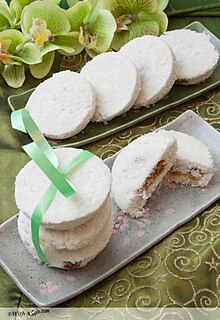
Bhapha Pitha-ভাপা পিঠা
Like other parts of the country, everyday meals generally include plain steamed rice as staple food with fish, meat, vegetable curries and lentil soup is common accompaniment. Plain rice is often replaced by roti or parata. Curry is the most popular style of preparing dishes.
But Old Dhaka area has its own unique food tradition, known as Dhakaiya food. Old Dhaka is famous for its Morog (Chicken) Pulao, its different from traditional biriyani by using both tumeric and malai or cream of milk together. Famous dishes of Old Dhaka are kebabs, naans, bakharkhani, kachchi and pakki biriyani, haleem, mutton bhuni kichuri, mutton tehari etc. Dhakai Bakarkhani is the traditional food or snack of the people of old Dhaka. It is famous for its quality and taste and it was highly praised by the royal court of the Mughal Empire in Delhi.Along with Bangladeshi cuisine and South Asian variants, a large variety of Western and Chinese cuisine is served at numerous restaurants and eateries.Often many restaurants customize fusion dishes which blends foreign and local cuisines to meet local taste. Local and international fast food shops and chains serve burgers, fries and other readily available foods. Street foods like Burhani, Lassi and Phuchka are highly popular among locals and tourists. Chita Pitha/ছিটা পিঠা & Bhapha Pitha/ভাপা পিঠা, a type of easy cake, made from rice flour also popular as street food. fast-food chains like A&W, Burger King, KFC, Nando's, Pizza Hut, Pizza Inn and Sbarro have opened up their outlets in major areas of the city. Dhaka's delicacies such as Biriani from Haji's, Nanna's and Fakhruddin, Dhaka Cheese, Star Kabab still remain popular for dine. The city has numerous venerable Bengali confectionery chains, including Banoful, Alauddin, Bikrampur Mishti Bhandar and Rashmela
Architectural landmarks and museums

View of Lalbagh Fort

Independence Monument
There are many museums in the city. Such as Ahsan Manzil, Bangladesh National Museum, Museum of Independence, Liberation War Museum, National Museum of Science and Technology (Bangladesh), Bangabandhu Memorial Museum etc.
Media
Dhaka is also the press, media and entertainment center of Bangladesh. Bangladesh Betar is the state-run primary provider of radio services, and broadcasts a variety of programming in Bengali and English. Radio transmission started in Dhaka on 16 December 1939. In recent years many private radio networks, especially FM radio services, have been established in the city such as Radio Foorti FM 88.0, Radio Aamar FM 88.4, ABC Radio FM 89.2, Radio Today FM 89.6, DhakaFM 90.4, Peoples Radio 91.6 FM, Radio Bhumi FM 92.8, City FM 96.0 etc. Bangladesh Television is the state-run broadcasting network that provides a wide variety of programmes in Bengali and English. It started broadcasting on 25 December 1964. It also operates a sister channel BTV World since 2004. Sangsad Bangladesh is another government-owned TV channel that broadcasts parliamentary activity of Bangladesh since 25 January 2011. Cable and satellite networks such as ATN Bangla, ATN News, Banglavision, Channel i, Channel 9, Ekushey Television, Gaan Bangla, Gazi Television, Independent TV, NTV, RTV and Somoy TV are amongst the most popular channels. The main offices of most publishing houses in Bangladesh are based in Dhaka. Dhaka is home to the largest Bangladeshi newspapers, including the leading Bengali dailies Prothom Alo, Ittefaq, Inqilab, Janakantha, Amar Desh and Jugantor. The leading English-language newspapers include The Daily Star, Dhaka Tribune, The Financial Express, The Independent and New Age.Education
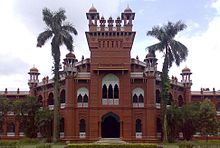
Curzon Hall in the University of Dhaka
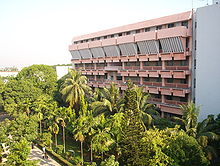
Civil Engineering Building of BUET

A block of BSMMU in Dhaka
The British Council plays an important role helping students to achieve GCSE and A Level qualifications from examination boards in the United Kingdom. This is in addition to holding several examinations for professional bodies in the United Kingdom, including the UK medical Royal Colleges and Accountancy.
Sports
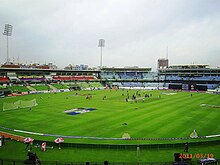
Sher-e-Bangla National Cricket Stadium, Mirpur
Dhaka has the distinction of having hosted the first official Test cricket match of the Pakistan cricket team in 1954 against India.The Bangabandhu National Stadium was formerly the main venue for domestic and international cricket matches, but now exclusively hosts football matches. It was used during Pakistan colonial era for Test matches when no Bengalis were selected in team and a matting pitch was used. It hosted the opening ceremony of the 2011 Cricket World Cup while the Sher-e-Bangla National Cricket Stadium, exclusively used for cricket, hosted 6 matches of the tournament including two quarter-final matches. Dhaka has also hosted the South Asian Games three times, in 1985, 1993 and 2010. Dhaka is the first city to host the games three times. The Bangabandhu National Stadium was the main venue for all three editions.Dhaka also hosted the ICC World Twenty20, along with Chittagong and Sylhet, in 2014.
The National Sports Council, responsible for promoting sports activities across the nation, is based in Dhaka. Dhaka also has stadiums largely used for domestic events such as the Bangladesh Army Stadium, the Bir Sherestha Shaheed Shipahi Mostafa Kamal Stadium, the Dhanmondi Cricket Stadium and the Outer Stadium Ground. The Dhaka University Ground and the BUET Sports Ground host many intercollegiate tournaments.They are also used as practice ground by different football clubs and visiting foreign national football teams.
There are two golf courses in Dhaka. One is situated at Army Golf Club and another is situated at Kurmitola Golf Club.
Transport
Road

Cycle rickshaws are the most popular mode of transport in Dhaka

Double-decker bus of BRTC
Dhaka suffers some of the worst traffic congestion in the world. The city lacks an organized public transport system. Construction of MRT and a BRT is currently going on to solve the problem. Cycle rickshaws and auto rickshaws are the main mode of transport within metro area, with close to 400,000 rickshaws running each day: the highest number in any city in the world.However, only about 85,000 rickshaws are licensed by the city government.Relatively low-cost and non-polluting cycle rickshaws, nevertheless, cause traffic congestion and have been banned from many parts of the city. The government has overseen the replacement of two-stroke engine auto rickshaws with "Green auto-rickshaws" locally called CNG auto-rickshaw or Baby-taxi, which run on compressed natural gas.
Public buses are operated by the state-run Bangladesh Road Transport Corporation (BRTC) and by numerous private companies and operators. Scooters, taxis and privately owned cars are rapidly becoming popular with the city's growing middle class.Limited numbers of Taxis are available. It is planned to raise the total number of taxis to 18,000 gradually. Uber has started mobile app based taxi service in the city.
Air

Runway and apron area of the Shahjalal International Airport
Rail
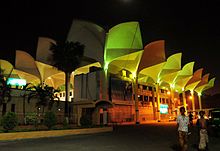
Night view of Kamalapur railway station
In 2013, suburban services to Narayanganj and Gazipur were upgraded using diesel electric multiple unit trains.
The Dhaka Metro Rail feasibility study has been completed. A 21.5 kilometres (13.4 mi), $1.7 Billion Phase 1, metro route is being negotiated by the Government with Japan International Cooperation Agency. The first route will start from Uttara, northern suburb of Dhaka to Sayedabad, southern section of Dhaka.The route consists of 16 elevated stations each of 180m long. Construction began on 26 June 2016.



Very informative article. You described very well Dhaka the magical city. You shows the list of tourist attractions in Dhaka. Keep it up! Thanks
ReplyDeletehttps://www.google.com/search?q=intitle:top+50+independence+day%22add+comment%22+%22subscribe+to:+post+comments+(atom)&sxsrf=AOaemvL0_PMyPfV8HOscqhggsZKOs3455w:1632916014760&ei=LlJUYazRLc-VsAfRpYugAQ&start=70&sa=N&ved=2ahUKEwisoIeYjqTzAhXPCuwKHdHSAhQ4PBDy0wN6BAgBEEE&biw=1707&bih=821&dpr=0.8
ReplyDeleteI would like to say that this blog really convinced me to do it! Thanks, very good post. jute bag in singapore to buy
ReplyDeletePretty good post. I just stumbled upon your blog and wanted to say that I have really enjoyed reading your blog posts. Any way I'll be subscribing to your feed and I hope you post again soon. Big thanks for the useful info. best jute bag in singapore
ReplyDeleteThis particular papers fabulous, and My spouse and i enjoy each of the perform that you have placed into this. I’m sure that you will be making a really useful place. I has been additionally pleased. Good perform! jute bags
ReplyDeleteThank you for the sharing good knowledge and information its very helpful and understanding!
ReplyDeleteCoaster for Rent in Islamabad
Whenever see this article, the first thing crossed my mind is Scenic Tour. They’re the best tour operator, I’ve ever experienced. They’re dedicated to discover the beauty of Bangladesh along with tourists from every corner of the world.
ReplyDelete